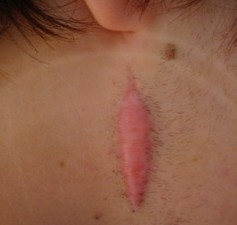Keloids
What are keloids?
Keloids are a type of scar of the skin that has too much collagen and scar tissue formation. Keloids occur after injury to the skin and are more common on the upper chest, upper back and shoulders. People with coloured skin (skin of colour) have a higher risk of developing keloids. Keloids may be large and disfiguring and can cause significant distress.

What causes keloids?
The cause of keloid formation is still not fully known. Excessive collagen (protein made in wound repair) formation occurs in areas of injury to the skin. The injury does not have to be major for a keloid to form. Injury to the skin includes burns, cuts, tattoos, injection sites, ear piercings, vaccinations or surgery. Keloids may also occur as a result of inflammation in the skin (such as in acne, insect bites or abscesses) or in areas of increased skin tension or tightness.
Keloids typically develop slowly and usually appear months after the skin injury. Keloid formation is rarely spontaneous (without an injury).
Keloids develop in those who are susceptible or prone to developing this type of scar.
Who is more at risk of developing a keloid?
There is a higher risk of developing a keloid scar if a person:
- Has a past history of keloid formation
- Has a family member with a keloid scar
- Has skin of colour (coloured skin).
What do keloids look like?
Keloids appear in all shapes and sizes and are essentially large scars. They are firm, smooth and shiny, and may be pink, red, brown or skin coloured. Keloids occur most commonly on the earlobes, upper chest, upper back and shoulder region, but they can occur anywhere on the body.
Keloids may cause itch, pain and a pulling or tight sensation. Movement may be restricted at the site of the keloid .
Keloids are different to hypertrophic scars, which are raised scars that do not grow beyond the boundaries of the original wound. Keloids, on the other hand, grow beyond the original area of injury and tend to be more permanent compared to hypertrophic scars.
What other problems can occur with keloids?
There are no internal problems or medical complications associated with this benign (harmless) condition. Keloids do not turn into cancer.
How are keloids diagnosed?
A doctor can usually diagnose this condition by looking at the skin. A skin biopsy may be required in some cases.
How are keloids treated?
- Prevention
It is best to aim to prevent keloid formation if possible. Keloids are often difficult to treat once they have occurred.
Keloids can be prevented by avoiding unnecessary surgery (e.g. cosmetic surgery), tension and injury to the skin (e.g. tattoos, body piercings) and by taking some precautions in those who are at high risk of developing keloids.
Conditions that have a high risk of scarring (e.g. acne) increase the risk of keloid formation and should therefore be treated as early as possible to try to prevent keloids from forming.
- Treatment options
Most treatment options for keloids aim to flatten and improve the appearance of the keloid and reduce associated symptoms. Some form of scar will usually still be visible on the skin after treatment.
Treatment options for keloids include:
-
- Steroid injections (intralesional steroids): this is the most commonly used treatment.
- Several injections are required for the keloid to flatten out.
- Pressure dressings and silicon sheets/gels: need to be applied over long periods.
- Strong steroid creams (often under occlusion) may help with the itch and sometimes the appearance of the keloid.
- Lasers (pulse dye laser): this may help reduce the redness associated with the keloid.
- Freezing with liquid nitrogen: this may help flatten the keloid
- Other treatments reported for keloids: oral pentoxifylline, topical or intralesion 5-fluorouracil and imiquimod
- Radiotherapy: not commonly used these days
In general, cutting the keloid out (i.e. surgery) often results in a larger keloid scar, unless the surgery is combined with other techniques (e.g. intralesional steroids, radiotherapy) or the surgeon is able to successfully reduce the tension on the wound.
This information has been written by Dr Michelle Rodrigues and Dr Eleni Yiasemides
Updated 10 August 2015